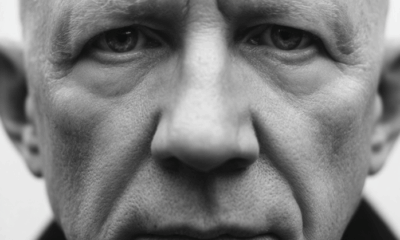Life
How to Let Go of Emotions and Thoughts That Hold You Down

Struggling to let go of situations, circumstances, and resentment? Can’t seem to shake off the negative thoughts and feelings that are lingering around? You know that you want to let them go, but you have no idea where to start or how to do this? If this sounds like you, then this is the article intended for you! This six-step process will help you let go of unwanted ideas and emotions and support you in choosing ones that will place you in alignment and harmony with your true self. By the end of this article, you will realise that you have all the power within you to direct and change your thoughts, feelings, and actions.
1. Feel what you feel
Begin this exercise by allowing yourself to feel what you are feeling by sitting with your emotions. Yep, that’s right; I’m suggesting that you sit with them and feel them, even if the thought of this scares you. This may be an uncomfortable and unpleasant task to undertake; however, the first step in letting go of your emotions is acknowledging their existence. Do this without resisting, criticising, fearing, judging, or feeling guilty about them. What does this mean? In other words, it implies not constructing a story about them but identifying them as just feelings. In this space, surrender to the emotions without trying to alter or resist them in any way.
2. Release them in a healthy way
Once you have sat with your emotions, it is now time to remove them from your mind in a healthy way. Each person has their own way of releasing thoughts and feelings, so finding what works for you is essential. Unfortunately, many people suppress, repress, or reactively express their emotions. By following these unhealthy forms, you only delay the process of letting go and create a feeling of stuckness, anxiety, and fear. Some examples of healthier ways to release these emotions are through journaling, crying, or exercising. Again, do not try and judge or generate a story about your feelings; just remove them from your mind.
3. Focus on your breathing
Our breath is one of our greatest yet underestimated blessings. When utilised to its potential, the breath is designed to help us relax, focus, and become aware of ourselves and our surroundings. To make the most of this incredible gift we have, get yourself into a comfortable position and pay attention to your breath. Close your eyes and take ten deep breaths, focusing on the inhale and exhale. Try to concentrate solely on the air entering and leaving your body without thinking about anything else. If thoughts or emotions appear, tell them that you will return to them shortly. After this exercise, begin to notice how your mind, body, and soul feel. In this tranquil state, you have an unblurred vision to make decisions and choose thoughts that work in your favour.
4. Step outside of yourself
Now that you are in a calmer state, you want to engage in this visualisation exercise. Begin by closing your eyes and imagining that you are stepping out of your physical body and looking down at yourself from a bird’s eye view. As you look down, send love, positive energy, and courage to yourself. Repeat the affirmations at least three times. “I choose to send you love, positive energy, and strength. You have all the answers you need to move forward with grace and freedom.” Then, praise yourself for engaging in activities that support your personal development.
5. Ask yourself
After your praise and acknowledgment, think of the idea or belief you want to let go. Then, ask yourself the following question, “Does this thought or belief serve me to my highest good?” If the answer is no, repeat this statement at least three times, “I choose to let this thought go, as it does not support me in my highest good.”
6. Use affirmations
After repeating this statement, mentally come back to your body. As you do, become aware of the new energy, perspective, and attitude you have. This calmer vibration will allow you to stay in control of your thoughts, feelings, and actions, and you will become more aware of the choices you make. As your day goes on, repeat the statement, along with affirmations that will keep you in a loving and conscious vibration. Examples include, I choose love, I choose to forgive myself and others, and I choose to let go of the past and be better in the now.
As you always have and always will have the ability to let go of thoughts that no longer serve you, this six-step process can assist you in all situations, regardless of the severity and intensity of the circumstance. Remember that no one but you has the power to choose what you hold on to and what you choose to let go of. This is your life; you decide how you live in each moment.
Life
10 Research-Backed Steps to Create Real Change This New Year
This New Year could finally be the one where you break old patterns and create real, lasting change.

Every New Year, we make plans and set goals, but often repeat old patterns. (more…)
Life
9 Harsh Truths Every Young Man Must Face to Succeed in the Modern World
Before chasing success, every young man needs to face these 9 brutal realities shaping masculinity in the modern world.

Many young men today quietly battle depression, loneliness, and a sense of confusion about who they’re meant to be.
Some blame the lack of deep friendships or romantic relationships. Others feel lost in a digital world that often labels traditional masculinity as “toxic.”
But the truth is this: becoming a man in the modern age takes more than just surviving. It takes resilience, direction, and a willingness to grow even when no one’s watching.
Success doesn’t arrive by accident or luck. It’s built on discipline, sacrifice, and consistency.
Here are 9 harsh truths every young man should know if he wants to thrive, not just survive, in the digital age.
1. Never Use Your Illness as an Excuse
As Dr. Jordan B. Peterson often says, successful people don’t complain; they act.
Your illness, hardship, or struggle shouldn’t define your limits; it should define your motivation. Rest when you must, but always get back up and keep building your dreams. Motivation doesn’t appear magically. It comes after you take action.
Here are five key lessons I’ve learned from Dr. Peterson:
-
Learn to write clearly; clarity of thought makes you dangerous.
-
Read quality literature in your free time.
-
Nurture a strong relationship with your family.
-
Share your ideas publicly; your voice matters.
-
Become a “monster”, powerful, but disciplined enough to control it.
The best leaders and thinkers are grounded. They welcome criticism, adapt quickly, and keep moving forward no matter what.
2. You Can’t Please Everyone And That’s Okay
You don’t need a crowd of people to feel fulfilled. You need a few friends who genuinely accept you for who you are.
If your circle doesn’t bring out your best, it’s okay to walk away. Solitude can be a powerful teacher. It gives you space to understand what you truly want from life. Remember, successful men aren’t people-pleasers; they’re purpose-driven.
3. You Can Control the Process, Not the Outcome
Especially in creative work, writing, business, or content creation, you control effort, not results.
You might publish two articles a day, but you can’t dictate which one will go viral. Focus on mastery, not metrics. Many great writers toiled for years in obscurity before anyone noticed them. Rejection, criticism, and indifference are all part of the path.
The best creators focus on storytelling, not applause.
4. Rejection Is Never Personal
Rejection doesn’t mean you’re unworthy. It simply means your offer, idea, or timing didn’t align.
Every successful person has faced rejection repeatedly. What separates them is persistence and perspective. They see rejection as feedback, not failure. The faster you learn that truth, the faster you’ll grow.
5. Women Value Comfort and Security
Understanding women requires maturity and empathy.
Through books, lectures, and personal growth, I’ve learned that most women desire a man who is grounded, intelligent, confident, emotionally stable, and consistent. Some want humor, others intellect, but nearly all want to feel safe and supported.
Instead of chasing attention, work on self-improvement. Build competence and confidence, and the rest will follow naturally.
6. There’s No Such Thing as Failure, Only Lessons
A powerful lesson from Neuro-Linguistic Programming: failure only exists when you stop trying.
Every mistake brings data. Every setback builds wisdom. The most successful men aren’t fearless. They’ve simply learned to act despite fear.
Be proud of your scars. They’re proof you were brave enough to try.
7. Public Speaking Is an Art Form
Public speaking is one of the most valuable and underrated skills a man can master.
It’s not about perfection; it’s about connection. The best speakers tell stories, inspire confidence, and make people feel seen. They research deeply, speak honestly, and practice relentlessly.
If you can speak well, you can lead, sell, teach, and inspire. Start small, practice at work, in class, or even in front of a mirror, and watch your confidence skyrocket.
8. Teaching Is Leadership in Disguise
Great teachers are not just knowledgeable. They’re brave, compassionate, and disciplined.
Teaching forces you to articulate what you know, and in doing so, you master it at a deeper level. Whether you’re mentoring a peer, leading a team, or sharing insights online, teaching refines your purpose.
Lifelong learners become lifelong leaders.
9. Study Human Nature to Achieve Your Dreams
One of the toughest lessons to accept: most people are self-interested.
That’s not cynicism, it’s human nature. Understanding this helps you navigate relationships, business, and communication more effectively.
Everyone has a darker side, but successful people learn to channel theirs productively into discipline, creativity, and drive.
Psychology isn’t just theory; it’s a toolkit. Learn how people think, act, and decide, and you’ll know how to lead them, influence them, and even understand yourself better.
Final Thoughts
The digital age offers endless opportunities, but only to those who are willing to take responsibility, confront discomfort, and keep improving.
Becoming a man today means embracing the hard truths most avoid.
Because at the end of the day, success isn’t about luck. It’s about who you become when life tests you the most.
Change Your Mindset
The Four Types of Happiness: Which One Are You Living In?
Most people chase success only to find emptiness, this model reveals why true happiness lies somewhere else.

In a world driven by rapid technological growth and constant competition, many people unknowingly trade joy for achievement. (more…)
Change Your Mindset
The Secret Daily Routines Behind History’s Most Brilliant Thinkers
Uncover the daily rituals and hidden habits that powered history’s most brilliant minds to success.

Why Daily Rituals Matter
Every great achiever has one thing in common: discipline. Behind the novels, inventions, discoveries, and masterpieces are small, consistent habits repeated daily. (more…)
-

 Personal Development4 weeks ago
Personal Development4 weeks agoThis Silent Habit Might Be Sabotaging Your Career
-

 Business3 weeks ago
Business3 weeks agoWhy Your E-Commerce Fulfilment Is Probably Broken (And How to Fix It)
-

 Shift Your Mindset3 weeks ago
Shift Your Mindset3 weeks ago11 E’s That Define Every Great Leader And Why Most People Miss Them
-

 Did You Know2 weeks ago
Did You Know2 weeks agoThe Success Patterns You Inherited (And Didn’t Notice)
-

 Business3 weeks ago
Business3 weeks agoThe Hidden Money Pit in Your Operations (and How to Use It)
-

 Entrepreneurs2 weeks ago
Entrepreneurs2 weeks agoThe Essential Skills Every Entrepreneur Needs In 2026
-

 Change Your Mindset1 week ago
Change Your Mindset1 week agoHow to Turn Your Mind Into Your Greatest Asset (Instead of Your Enemy)
-

 Change Your Mindset6 days ago
Change Your Mindset6 days agoThe Silent Skill That Makes People Respect You Instantly


























